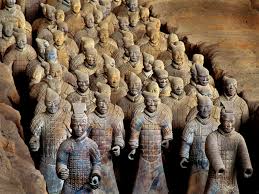
The Terracotta Army: Guardians of the First Emperor
A Silent Army Awakes
Buried for over two millennia, a vast army of over 8,000 life-sized terracotta soldiers silently stands guard over the tomb of Qin Shi Huang, China’s first emperor. This extraordinary collection, known as the Terracotta Army, is one of the most significant archaeological discoveries of the 20th century, offering an unparalleled glimpse into the military might and artistry of ancient China.
The First Emperor and His Legacy
Qin Shi Huang, who reigned from 246 to 221 BC, unified the warring states of China and established the Qin dynasty. He was an ambitious and ruthless ruler who sought to solidify his power and ensure his legacy for eternity. Central to this ambition was the construction of a magnificent mausoleum complex, a project that began shortly after he ascended the throne at the age of 13.
The Discovery of an Underground Empire
The Terracotta Army lay hidden beneath the earth for centuries until its accidental discovery in the spring of 1974. On March 29th, a group of farmers digging a well near the city of Xi'an, Shaanxi Province, stumbled upon fragments of terracotta figures and bronze weapons. Little did they know they had unearthed the entrance to one of the world’s greatest archaeological treasures.
A Glimpse into Ancient Military Might
Excavations revealed row upon row of terracotta warriors, each one unique in its facial features, hairstyle, and attire, showcasing the incredible craftsmanship of the Qin artisans. The army is a meticulously organized military formation, comprised of:
- Infantry: Standing in various poses, some armed with bronze swords or spears.
- Archers: Positioned in kneeling and standing formations, ready to unleash a volley of arrows.
- Charioteers: Accompanied by life-sized bronze chariots, complete with horses.
This lifelike depiction of the Emperor's army served not just as a display of military power, but also as a symbolic guard meant to protect him in the afterlife.
More Than Just Soldiers
The Terracotta Army pits represent more than just a military force; they offer a window into the social and technological aspects of the Qin Dynasty. The figures' clothing and armor styles, the intricate hairstyles, and the weapons they carry provide valuable insights into the fashion, hierarchy, and military technology of the era. Furthermore, the sheer scale of the project, requiring the labor of thousands of skilled artisans and laborers, speaks volumes about the Qin Dynasty's organizational capabilities.
A World Heritage Treasure
Today, the Terracotta Army is a UNESCO World Heritage Site and attracts millions of visitors from around the globe. The site consists of several pits housing different parts of the army, along with a museum showcasing excavated artifacts. Research and conservation efforts continue, with new discoveries constantly adding to the intrigue surrounding this ancient wonder.
The Mystery Endures
Despite the wealth of information gleaned from the Terracotta Army, many questions remain unanswered. The exact location of Qin Shi Huang's tomb within the vast complex remains undiscovered, as does the true extent of the treasures it may hold. The Terracotta Army continues to captivate and intrigue, reminding us of the grandeur and sophistication of China's ancient past.
Q&A
Q: When was the Terracotta Army discovered?
A: The first figures were discovered in 1974.
Q: Why was the Terracotta Army created?
A: The army was created to protect and serve the first Emperor of China, Qin Shi Huang, in the afterlife.
Q: What is the significance of the Terracotta Army?
A: The Terracotta Army provides invaluable insights into the military organization, artistry, and culture of the Qin Dynasty, making it one of the most important archaeological discoveries of all time.